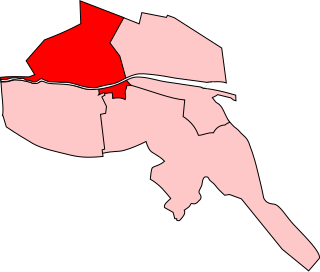Related Research Articles

In the United Kingdom (UK), each of the electoral areas or divisions called constituencies elects one member to the House of Commons.
Londonderry City was a parliamentary constituency in Ireland. It returned one Member of Parliament (MP) to the House of Commons of the Parliament of the United Kingdom, elected by the first past the post voting system.

In the United Kingdom, a Member of Parliament (MP) is an individual elected to serve in the House of Commons of the Parliament of the United Kingdom.
Cromac, a division of Belfast, was a UK parliamentary constituency in Ireland. It returned one Member of Parliament (MP) to the House of Commons of the United Kingdom from 1918 to 1922, using the first past the post electoral system.
Duncairn, a division of Belfast, was a UK parliamentary constituency in Ireland. It returned one Member of Parliament (MP) to the House of Commons of the United Kingdom from 1918 to 1922, using the first past the post electoral system.
Ormeau, a division of Belfast, was a UK parliamentary constituency in Ireland. It returned one Member of Parliament (MP) to the House of Commons of the United Kingdom from 1918 to 1922, using the first past the post electoral system.

College Green, also called Dublin College Green or College Green Division, Dublin, was a UK parliamentary constituency in Dublin. It returned one Member of Parliament (MP) to the House of Commons of the Parliament of the United Kingdom from 1885 to 1922.

The Government of Ireland Act 1920 was an Act passed by the Parliament of the United Kingdom to create two separate parliaments in Ireland: the Parliament of Northern Ireland and the Parliament of Southern Ireland. A Schedule to this act provided the constituencies for the House of Commons in these parliaments. These constituencies also replaced those provided in the Redistribution of Seats (Ireland) Act 1918 for representation of Ireland in the House of Commons of the United Kingdom at Westminster. Sinn Féin used these constituencies to elect the Second Dáil (1921–22) and those constituencies in Southern Ireland were used to elect the Third Dáil (1922–23).
Antrim Borough was a two-member borough constituency used to elect members of the Parliament of Ireland.
Belfast was a constituency represented in the Irish House of Commons until 1800.
References
- "Part II; Parliaments of Ireland". Return of the name of every member of the lower house of parliament of England, Scotland, and Ireland, with name of constituency represented, and date of return, from 1213 to 1874. Command papers. C.69-I. HMSO. 1878. pp. 603–691.
- Johnston-Liik, Edith Mary (2001-11-01). History of the Irish Parliament: 1692-1800; Commons, Constituencies and Statutes. Ulster Historical Foundation. ISBN 9781903688090.